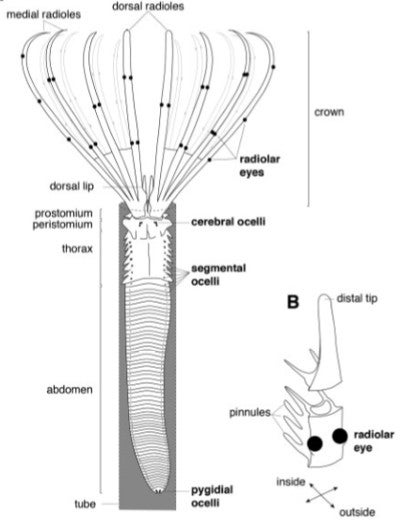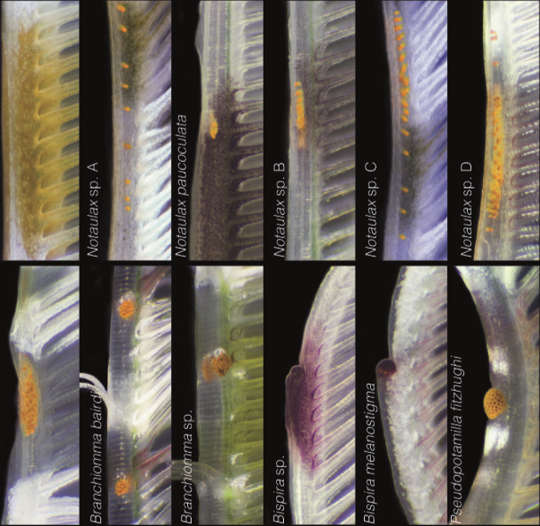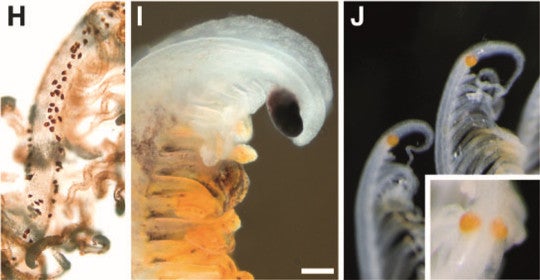This article was published in Scientific American’s former blog network and reflects the views of the author, not necessarily those of Scientific American
Fanworms do, in fact, have eyes in the usual location: their heads. But since the worms have now reside in lovely, cozy mucus tubes with only a crown of colorful tentacles protruding, that means they’re also not in a position to actually see anything. And that is a problem.
The tentacular crown, composed of structures called radioles, is crucial to the fanworm game plan: it’s how they eat and breathe. Only trouble is, this spectacular and essential accessory is also a convenient handle for hungry predators in search of, say, a fat worm dinner.
So fanworms have had to get creative. And boy, have they ever risen to the occasion, according to a recent review in Integrative and Comparative Biology by a team of Scandanavian scientists. These worms have added eyes like kids apply googly-eye stickers. Various species have grown eyes -- or at least simple light receptors called ocelli -- on their thorax, their abdomen, and even on their butts.
On supporting science journalism
If you're enjoying this article, consider supporting our award-winning journalism by subscribing. By purchasing a subscription you are helping to ensure the future of impactful stories about the discoveries and ideas shaping our world today.

Credit: Bok et al. 2016
Many, many species have also found ways to apply eyes at various locations and combinations up and down their radioles, including big compound clusters at the tips that give the appearance of crab eyestalks, except weirder.

Two compound eyes at the tip of fanworm radiolar tentacles (arrowhead). At right, a closeup of the compound eye. Scale = 100 micrometers. Credit: Bok et al. 2017
In this image, you can see the range of complexity in fanworm tentacular peepers from none to tons. The orange spots are ocelli, but toward the lower right they are starting to be clustered into structures that might be described as eyes. Insect compound eyes are composed of ocelli also.

Side views of freshly dissected radiolar eyes in 12 species of fanworms, organized in order of increasing sophistication from top left to bottom right. Fanworm at upper left lacks radiolar eyes. Credit: Bok et al. 2016
And here are yet more possibilities. The little brown balls on the left are ocelli. The black blobs center and yellow blobs at right are suspected eyes.

Scattered ocelli in Sabellomma cupoculata (H), a stalked eye in Stylomma palmatum (I), and possible paired eyes in Parasabella bioculata. Credit: Bok et al. 2016
It’s like an early-1980s Jim Henson Studios was given the license to design fanworm vision systems, and they did not hold back.
In addition to their unorthodox ideas on eye placement and design, fanworms have also built what are some fundamentally weird eyes for invertebrates. Although they superficially resemble invertebrate eyes, the microstructures and molecules involved seem to share more with -- of all things -- the eyes of vertebrates. Us.
Understanding how this biochemically bizarre optical free-for-all came to be requires understanding a little bit about fan worm evolution. Fan worms evolved from annelid worms (the segmented group that also produced the lowly earthworm). As such, their ancestors were not sedentary and did not live in tubes. They were something more like the polychaete worms that scuttle about the ocean today. And they certainly had eyes on their head.
Sometime in the early Jurassic, that changed when the first fanworms decided to relinquish their ramblin’ ways, build a nice mucus tube onto which they could maybe slap some defensive sedimentary bling, and nest in peace. But now their heads were safely tucked into their tubes with only their feathery feeding and breathing tentacles extended into the ocean, in a position that made them effectively blind and manifestly vulnerable.
Selection pressure, to put it euphemistically, ensued.
The result seems to have been that eyes evolved many times in many different groups of the desperate survivors from whatever light-sensing pigments and structures came to hand.
The butt eyes – pygidial eyes, to be less crude and more precise – are quite simple, and their job seems to be to find the darkest spot to build a new tube if a worm has been unhoused. The thorax eyes seem to alert worms who’ve embarrassingly exposed themselves to clamber back down into the tube.
Together with the cerebral eyes – little more than simple pigment cups now, buried inside fanworm brains – all these eyes do little more than detect light. And they are structurally and biochemically similar to the eyes of other invertebrates.
The tentacular eyes, on the other hand, are cut from very different cloth. Photoreceptors can be constructed from two types of cellular protrusions: microvilli, and cilia. A microvillus is a little finger-like cell membrane projection. Our small intestines are lined with these (they help us absorb nutrients). A cilium is a beating hair. Our tracheas are lined with these (they help us eject lung crud).
Invertebrate photoreceptors tend to be built from co-opted microvilli. Vertebrate photoreceptors tend to be built from from repurposed cilia. Fanworms’ tentacular eyes have also been constructed from cilia. In at least one case where the protein has been sequenced, as revealed in the journal Current Biology last year, they also use the same types of light-sensing molecules – C-opsins -- employed by vertebrates in their ciliary photoreceptors (invertebrate-type receptors use Gq-opsins).
Moreover, mapping tentacular eyes’ appearance and complexity onto a family tree of fanworms suggests it is likely that these eyes evolved from vertebrate-like components not once, but two or three separate times. Since such eyes respond to shadows – and especially moving shadows -- they seem to have evolved to serve as security systems. When tripped, the worm vanishes.
In fact, it may be the reason these eyes evolved several times from the same components is for this very reason: unlike shadow-sensitive C-opsins, invertebrate-style Gq-opsins are triggered by light increases, a much less useful feature for home security.
Sequencing of one fanworm C-opsin has revealed that although it is related to vertebrate C-opsins, it does not appear to have been picked up from them by horizontal gene transfer – that is, direct passing or stealing of genes. Rather, invertebrates seem to have inherited simple C-opsins of their own from a common ancestor, called InvC-opsins. They are far from the only invertebrates that use them. The marine ragworm Platynereis dumerilii uses one such InvC-opsin in simple ciliary photoreceptors in the brains of their larvae, possibly for sensing ambient light levels. But they do seem to be the only invertebrates to have used them to build highly complex eyes.
What seems to have happened in fanworms is that a few simple, ciliated photoreceptors employed only in sensing ambient light happened to be hanging out in the vicinity of the radiolar tentacles, minding their own business, when the fanworm nabbed them and gave them a new job as lookouts.
Or rather -- the fanworms who were able to make use of these photoreceptors to help detect predators survived and reproduced, and successive generations of offspring with better versions of these eyes left successively more offspring. Some of the resulting compound eyes resemble and rival those made by arthropods – but they are built on optical subunits much more closely related to the ones used to construct our eyes.
It is possible these eyes provide only shadow-detection. But it is also possible the compound eye versions may be capable of rudimentary motion detection and image formation, and that fanworms have something like “vision” as a result.
The sheer abundance and bizarre distribution of these eyes on the tentacles of filter-feeding worms begs a few other brain-tickling questions: how do you keep the burglar alarm from going off every time one tentacle drifts in front of another? How does one integrate the visual signal of a bunch of eyes spread out over a bunch of tentacles all pointing in crazy directions? Is it possible to have too many eyes? (Fanworms: NO.)
The United States are often referred to as Laboratories of Democracy because U.S. states have so much freedom to experiment with their laws. Fanworms are Laboratories of Ophthalmology, and a ripe target for those interested in studying what is possible when animals throw out the existing eye rulebook and begin again.
References
Bok, Michael J., María Capa, and Dan-Eric Nilsson. "Here, there and everywhere: the radiolar eyes of fan worms (Annelida, Sabellidae)."Integrative and Comparative Biology, 56: 5 (2016): 784-795.
Bok, Michael J., Megan L. Porter, and Dan-Eric Nilsson. "Phototransduction in fan worm radiolar eyes." Current Biology 27, no. 14 (2017): R698-R699.